
Gemme kunzite : un guide complet sur ses propriétés, ses vertus curatives et sa valeur
 La kunzite est une pierre précieuse rose à violette découverte seulement en 1902. Cette gemme est le membre le plus connu de la famille des minéraux du spodumène bien qu'elle soit la plus jeune.
La kunzite est une pierre précieuse rose à violette découverte seulement en 1902. Cette gemme est le membre le plus connu de la famille des minéraux du spodumène bien qu'elle soit la plus jeune.
Cette gemme se distingue par son excellente clarté, ses couleurs enchanteresses et son fort pléochroïsme (affichant différentes couleurs sous différents angles de vue).
Mis à part les gemmologues, la plupart des gens ne connaissaient pas la kunzite jusqu'à une vente aux enchères de Sotheby's en 1996. Cette année-là, l'un des articles disponibles était une grande bague en kunzite (accentuée de diamants) appartenant à l'ancienne première dame Jackie Kennedy.
Son mari, le président John F. Kennedy, l'a acheté comme cadeau de Noël quelques semaines seulement avant son assassinat en novembre 1963. Il a finalement été vendu pour 431 250 $ !
Ne vous inquiétez pas, la kunzite regorge de qualités lumineuses et joyeuses ! Nous les passerons en revue aujourd'hui en revue : significations, propriétés curatives, prix et bien plus encore.

Qu'est-ce que la kunzite ?
La kunzite est une pierre semi-précieuse aux douces et romantiques nuances roses à violettes. Subtile et magnifique, elle s'accorde avec toutes les tenues, mais on la surnomme la « pierre du soir » car, malheureusement, elle pâlit souvent sous la lumière directe du soleil.
D'abord appelée « spodumène lilas », la kunzite est aujourd'hui connue sous d'anciens noms commerciaux, notamment la salmonite, la faucille et l'« iris de Californie ». Tous ces noms sont liés à son histoire controversée, que nous aborderons plus loin !
Des bébés pour la Saint-Valentin ? Vous serez ravi(e) d'apprendre que la kunzite est une pierre de naissance alternative pour février ! C'est aussi une pierre du zodiaque pour le Taureau, le Lion et le Scorpion.
Si vous célébrez bientôt un 32e anniversaire de mariage mais que vous avez un budget limité, la kunzite est une alternative plus abordable à la morganite traditionnelle !
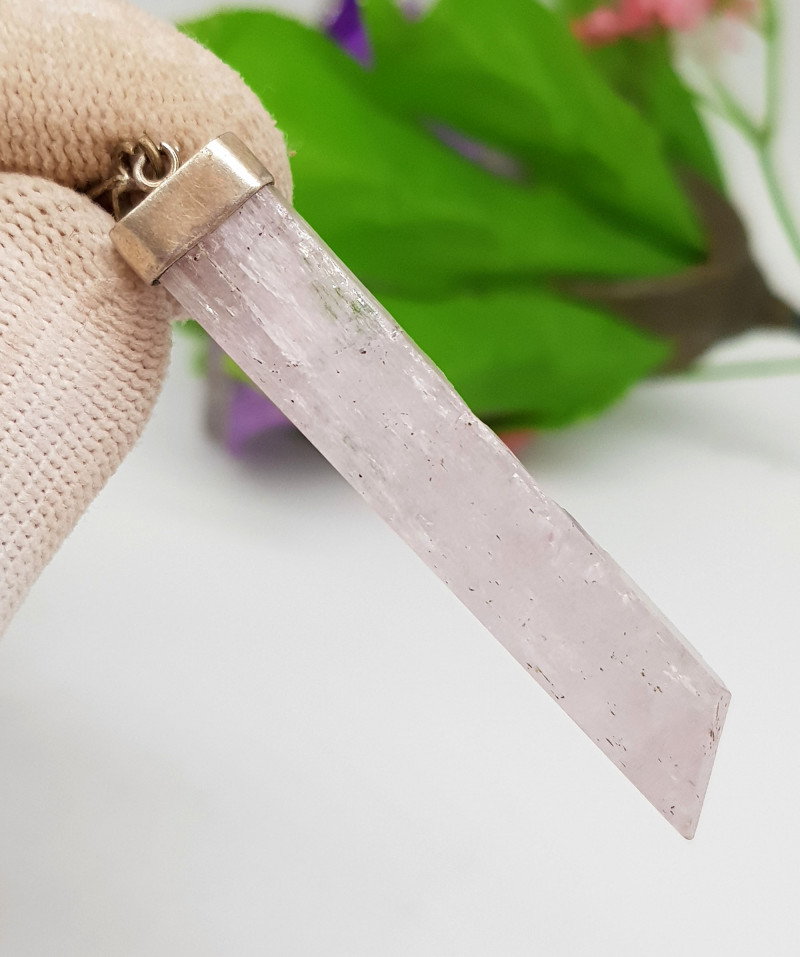
Spécifications et caractéristiques de la kunzite
La kunzite est un silicate de lithium et d'aluminium, tout comme l' hiddenite, une pierre de spodumène. Ses teintes douces proviennent de faibles quantités de manganèse qui se sont infiltrées lors de sa formation.
La kunzite est-elle rare ? Plutôt. La kunzite n'est vraiment rare que dans les couleurs saturées, et elle est loin d'être aussi rare que l'hiddenite.
Voici les propriétés restantes de la kunzite :
Dureté Mohs : 6,5-7
Couleur : rose, violet ou lilas
Structure cristalline : Monoclinique
Lustre : Vitreux (semblable à du verre)
Transparence : Transparent à translucide
Indice de réfraction : 1,66-1,68
Densité : 3,1-3,2
Décolleté : Parfait, 2 directions
Fracture : Inégale à sous-conchoïdale
Série : Blanche
Luminescence : Phosphorescence (lueur durable) en rose orangé ; parfois thermoluminescence (lueur induite par la chaleur) en orange
Pléochroïsme : Fort en incolore, violet et rose
Passant du minéral au métaphysique, que symbolise la pierre kunzite ?
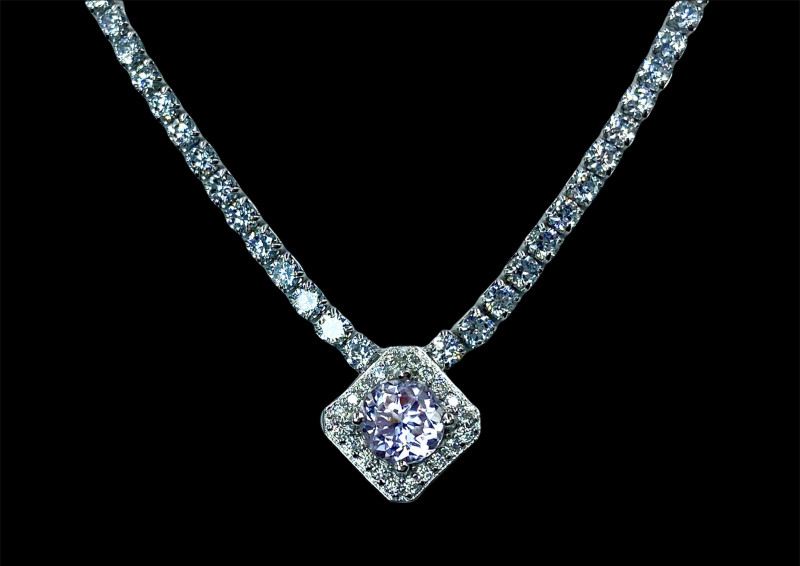
Signification et histoire de la kunzite
Bien que relativement moderne, la kunzite a acquis une multitude de significations au cours du siècle dernier. Ses teintes roses évoquent la guérison, l'amour inconditionnel et la bonté.
De nombreuses qualités féminines ont été attribuées à la kunzite, depuis les légendes selon lesquelles les femmes qui la portent trouveront leur véritable amour jusqu'aux croyances selon lesquelles elle représente la fertilité.
Le nom « kunzite » rend hommage à George Kunz, un gemmologue renommé de Tiffany. Contrairement à la croyance populaire, Kunz n'a pas découvert la pierre précieuse. Cependant, au moins quatre mineurs différents pourraient s'en attribuer le mérite.
Histoire : Qui a découvert la kunzite en premier ?
La première découverte de kunzite a eu lieu vers 1902 près de Pala, en Californie, aux États-Unis. Le premier découvreur présumé dont nous parlerons est Frederick M. Sickler .
Sickler a trouvé les spécimens dans la mine White Queen, puis les a transmis à George Kunz en 1902. Kunz s'est rendu compte qu'il s'agissait potentiellement d'une nouvelle variété de spodumène.
Kunz envoya des échantillons à Charles Baskerville, professeur de chimie à l'Université de Caroline du Nord, qui choisirait finalement le nom. Ensemble, ils publièrent la première description complète de la gemme en 1904.
Autres découvreurs
Fin 1902, HC Gordon, l'un des correspondants de Kunz à la mine, écrivit à Kunz pour préciser que les mineurs Pedro Peiletch et Beranardo Heriart l'avaient trouvé avec Sickler à la mine White Queen.
Pour ajouter à la confusion, un journal local publia que Frank A. Salmons avait en réalité découvert la gemme en premier à la mine de Pala Chief. En 1904, Sickler écrivit à Kunz à ce sujet, ajoutant que les exploitants de la mine de Pala Chief (dont Salmons) prétendaient à tort que leur gisement était le seul .
À ce stade, Kunz s'en remettait aux exploitants de la mine Pala Chief pour obtenir la meilleure kunzite brute. Pour trancher la question, Kunz affirma dans son rapport que Sickler « semblait » être le découvreur légitime.
Noms commerciaux
Plus d'une décennie plus tard, en 1915, Kunz avait encore quelques différends.
Le secrétaire en chef de la mine de Pala, R. Fenton, a fait pression pour le nom commercial « iris de Californie », qui avait gagné du terrain sur les marchés européens, mais Kunz pensait que « kunzite » était le nom approprié (et non un nom commercial distinct).
Le nom « iris de Californie » disparut cependant rapidement. Salmons écrivit à Kunz en 1919 pour lui proposer d'autres échantillons de « kunzite » ; visiblement, même Salmons avait abandonné la lutte.
Heureusement, Sickler et Salmons avaient chacun des minéraux complètement distincts (la sicklerite et la salmonite) qui portaient leur nom en 1912.

Propriétés curatives de la kunzite
Toutes les pierres précieuses peuvent être des pierres de guérison efficaces pour traiter différents maux. À quoi sert la kunzite ?
Pierre précieuse rose , la kunzite rose possède des propriétés curatives liées à la fertilité, à la romance et à l'amour. Il n'est donc pas surprenant qu'elle soit une pierre puissante pour le chakra du cœur ! La kunzite violette, comme d'autres pierres violettes , peut apporter créativité, passion et sagesse spirituelle.
Lisez la suite pour découvrir les bienfaits physiques et émotionnels de la pierre kunzite !
Guérison physique
Les utilisations générales supposées de la kunzite incluent le soutien du système cardiovasculaire et la reproduction cellulaire. La nature féminine du cristal de kunzite pourrait avoir des bienfaits pour les femmes, comme le traitement des déséquilibres hormonaux, des douleurs liées à la grossesse et de la dépression post-partum.
Guérison émotionnelle
La kunzite peut faire des merveilles pour la guérison émotionnelle, dissipant la solitude et ouvrant votre cœur pour vous aimer inconditionnellement, aimer les autres et même la nature.
Cette pierre peut harmoniser votre esprit et vos émotions. On dit qu'elle favorise l'expression personnelle et insuffle à votre esprit une joie de vivre .
C'est certainement un cristal de guérison précieux, mais la kunzite est-elle une pierre précieuse de valeur ? Tout dépend de sa qualité.
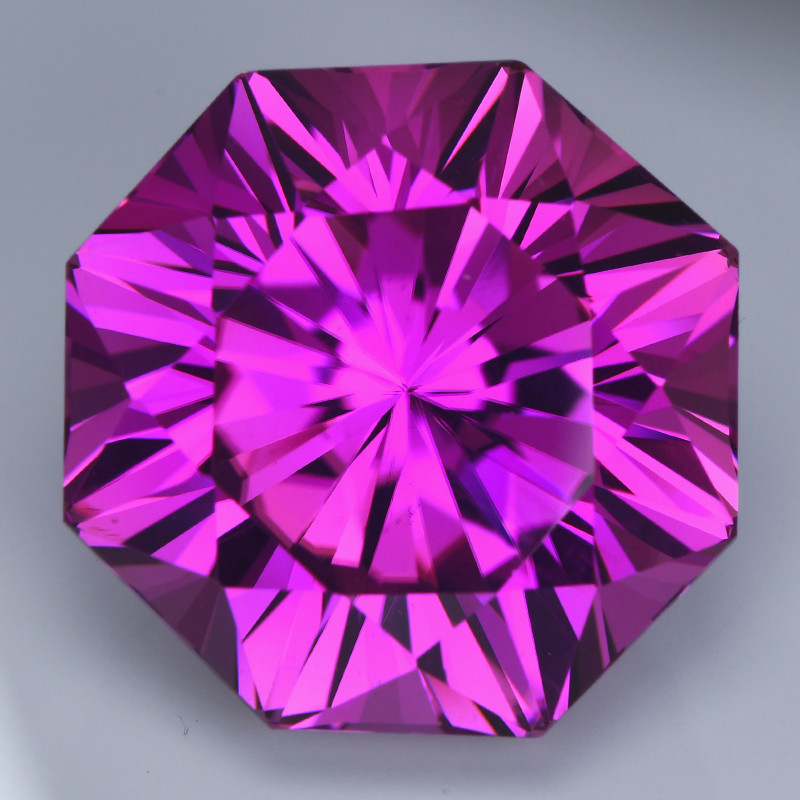
Propriétés de la pierre précieuse kunzite
La gamme de bijoux en kunzite est suffisamment diversifiée pour répondre aux besoins de tous les acheteurs. Pour être un acheteur avisé, il est essentiel de savoir quoi rechercher.
Les experts déterminent la valeur de la kunzite de la même manière que la plupart des pierres précieuses, en fonction de sa couleur, de sa clarté, de sa taille, de son poids en carats et de ses traitements.
Couleur
Le facteur de valeur le plus important est la couleur de la kunzite. La plupart des pierres de kunzite sont pâles, généralement rose clair. Certaines sont si pâles qu'elles paraissent incolores avec une légère nuance rosée. D'autres teintes roses incluent le rose pêche et le rose lilas.
Quelle est la plus belle couleur de kunzite ? Les teintes roses saturées et les teintes violettes ou magenta vives, plus rares, sont les plus prisées. Les kunzites bicolores sont également très prisées.
Clarté
La kunzite présente rarement, voire jamais, d'inclusions visibles, ce qui lui confère une pureté de type I. Cela signifie que la plupart des pierres précieuses ont une bonne clarté, ce qui n'affecte pas trop leur valeur.
Selon GemVal, près de 65 % des kunzites qu'ils ont évaluées relèvent de la catégorie VVS (Very Very Slightly Included), la catégorie de clarté la plus élevée.
Il est compréhensible que toutes les pierres précieuses avec des inclusions visibles aient une valeur inférieure, mais vous ne devriez pas avoir de difficulté à trouver des kunzites sans inclusions.
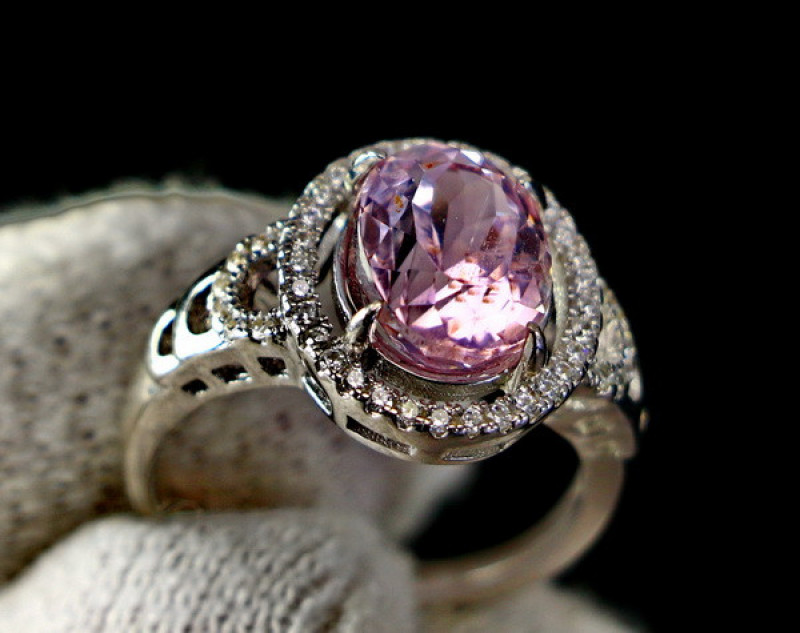
Couper
Le clivage parfait de la kunzite dans deux directions et sa couleur la plus forte sur le côté le plus long (du cristal) la rendent quelque peu difficile à tailler, mais extrêmement gratifiante si elle est bien faite.
L'absence générale d'inclusions ouvre la voie à de magnifiques tailles facettées , notamment des tailles en gradins comme l'émeraude ou les coussins. On trouve cependant cette pierre dans pratiquement toutes les tailles, y compris les cabochons et les sculptures !
Poids en carats
Le poids en carats n'a pas d'impact significatif sur la valeur de la kunzite, car on la trouve souvent en grandes tailles. Les pierres précieuses de 10 à 20 carats sont assez courantes. Le prix au carat des pierres de moins de 5 carats ne connaît qu'une légère augmentation par rapport à celles de plus de 10 carats.
Le Smithsonian expose actuellement la plus grande kunzite à facettes connue : une énorme gemme de 880 carats !
Traitements
Certaines gemmes de kunzite subissent une irradiation, un chauffage, ou les deux traitements pour rehausser ou modifier leur couleur. L'irradiation, puis le chauffage, donnent à la kunzite incolore une teinte rose. Des traitements thermiques à basse température (100-250 °C) peuvent lui donner une teinte rose-violet à rose clair.
De plus, la kunzite dont la couleur a pâli suite à une exposition au soleil (blanchie à chaud) peut parfois être restaurée par irradiation. Cependant, il est nécessaire de la chauffer ou de la mettre à la lumière immédiatement après pour éliminer les nuances brunes ou vertes.
Les experts soulignent que les traitements de certains pays peuvent être plus stables. De nombreuses kunzites traitées à Taïwan ou au Brésil conservent mieux leur couleur que celles traitées au Pakistan.
Cependant, la kunzite traitée est souvent plus sujette à la décoloration au soleil que la kunzite non traitée.

Formation et sources de kunzite
La kunzite se forme à l'intérieur des pegmatites riches en lithium. Tout d'abord, du magma chaud remonte sous terre, plus près de la surface terrestre. À mesure que le magma refroidit, des cavités, des veines et des bulles de gaz se forment.
L'eau pénètre à ces endroits, ramassant au passage des minéraux dissous comme la silice. En se déposant, l'eau finit par s'évaporer et les minéraux cristallisent. Pour que la kunzite se forme, la présence de manganèse est nécessaire pour donner à la gemme sa couleur caractéristique.
Emplacements miniers
Bien que le premier site de kunzite en Californie soit toujours une source importante, la plupart des kunzites proviennent actuellement du Pakistan et d'Afghanistan.
D'autres sources incluent :
Brésil
Canada
Madagascar
Myanmar (Birmanie)
Suède
États-Unis (Caroline du Nord et Dakota du Sud)
Les kunzites d'Afghanistan présentent notamment un pléochroïsme intense, parfois violet intense, vert clair et violet clair. Certains experts estiment également que la kunzite de Pala, en Californie, est moins photosensible (elle a tendance à pâlir au soleil).
En parlant de sa qualité, combien vaut la kunzite ?

Prix et valeur de la kunzite
Malgré sa beauté luxueuse, la plupart des pierres de kunzite coûtent moins de 20 $ le carat. Pourquoi la kunzite est-elle si bon marché ? Peu de gens la connaissent, et sa popularité ne stimule pas la demande (et donc les prix).
Ce n’est en aucun cas « bon marché » au sens courant du terme – sa qualité peut rivaliser avec celle du saphir rose à une fraction du prix.
La couleur est un facteur déterminant du prix de la kunzite. Voici les tarifs de gros généraux pour les kunzites facettées, par couleur :
Rose clair : 5 à 10 $ par carat
Rose moyen : 15 à 30 $ par carat
Lilas : 10 à 30 $ le carat
Violet foncé ou magenta : 20 à 60 $ par carat
Bien que ces pierres précieuses soient souvent de grande taille, les kunzites de plus de 10 carats (même dans des tons plus clairs) peuvent coûter jusqu'à 180 $ par carat.
Les cabochons de kunzite sont beaucoup moins chers, allant de 0,30 $ à 3 $ le carat en gros. Vous pouvez vous attendre à payer encore moins cher pour la kunzite brute , entre 0,03 $ et 1,50 $ le carat.
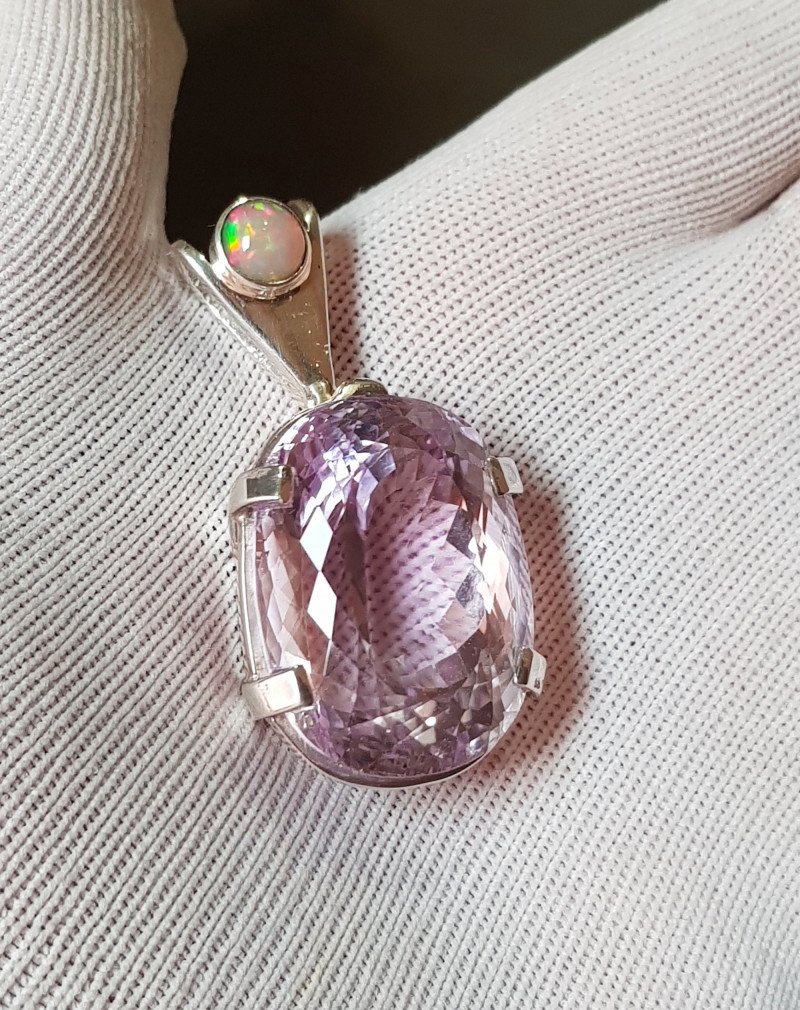
Entretien et maintenance de la kunzite
La kunzite présente une dureté raisonnable, mais son clivage bidirectionnel parfait signifie qu'un choc violent peut la fendre en deux, quel que soit l'angle. Nous vous recommandons d'opter pour des bijoux moins fragiles, comme des pendentifs ou des boucles d'oreilles en kunzite. Vous pouvez également protéger votre bague en kunzite avec une monture protectrice .
L'aspect le plus important de l'entretien de la kunzite, surtout si elle est traitée, est d'éviter de l'exposer directement au soleil ou à la chaleur. Évitez de porter des bijoux en kunzite les jours ensoleillés.
La décoloration n'est pas instantanée ; certains experts affirment que de nombreuses kunzites naturelles perdent de 5 à 15 % de leur couleur au fil des ans. Cependant, chaque pierre étant différente, il est préférable de faire preuve de prudence.
Nettoyer la kunzite est simple. Frottez-la délicatement avec une brosse à dents souple imbibée d'eau tiède et de savon doux. Rincez ensuite les résidus et séchez avec un chiffon en microfibre.
Conservez votre pierre précieuse ou vos bijoux en kunzite dans un endroit sombre et frais, à l'écart des autres pierres précieuses.
Êtes-vous passionné par la kunzite ?
Maintenant que vous connaissez la kunzite, vous comprendrez aisément pourquoi cette pierre rose est un trésor sous-estimé. Son rose séduisant captive instantanément, nourrit l'amour et encourage à exprimer sa créativité et son charisme !
À la recherche d'une gemme rose douce et captivante ? Achetez des pierres précieuses kunzite dès aujourd'hui !
Rechercher le Gemstone Encyclopedia
Enchères associées
Articles Liés
Il existe des dizaines de quartz et de calcédoine aux couleurs et motifs variés. Découvrez les propriétés du quartz et tous ses types, de l'améthyste et l'agate au quartz plasma et au quartz fantôme !
15th Oct 2020
Laissez-nous vous expliquer comment acheter des pierres précieuses sur Internet. Nous proposons la plus grande sélection de pierres précieuses sur Internet, et cela peut être un peu compliqué au début. Laissez-nous vous guider avec quelques conseils utiles.
3rd Oct 2018
L'améthyste est un quartz aux nuances variées d'un violet éclatant. Découvrez son histoire, ses propriétés, sa valeur et ses utilisations dans ce guide informatif !
5th May 2021
Derniers articles
La gaylussite est un minéral rare, principalement utilisé dans l'industrie, car elle se trouble facilement en se déshydratant. Découvrez l'histoire, les propriétés, les utilisations et les caractéristiques de la gaylussite dans ce guide complet.
7th Dec 2025
La chiolite est un minéral rare, incolore à blanc, apparenté à la cryolite. Les gemmes sont très rares et proviennent de quelques gisements seulement. Découvrez ici les utilisations, l'histoire, les prix et les caractéristiques de la chiolite.
5th Dec 2025
La bréithauptite est un minéral d'antimoine de couleur rouge cuivré à violette, apparenté à la nickeline, connu pour son éclat métallique et ses liens avec les minerais d'argent. Découvrez l'histoire, les caractéristiques, la valeur et les utilisations de la bréithauptite !
21st Nov 2025
Catégories d'articles
How To's is where you will find helpful articles from gem Rock Auctions on how to cut gemstones, select gemstones and buy gemstones.
9 les articles





